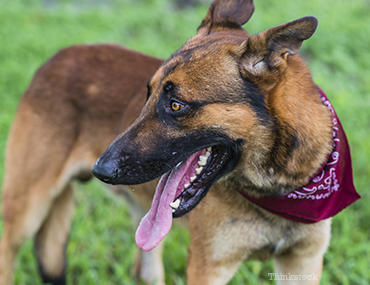
Thankfully, intussusception is a word that most people have neither heard of nor have had to deal with. Although it is a relatively uncommon gastrointestinal problem, it can be fatal if not treated promptly and therefore should be on everyone’s radar.
What is an intussusception?
Intussusception occurs when a portion of gastrointestinal (GI) tract gets trapped inside the lumen of adjoining GI tract. This “telescoping” effect can lead to a partial or complete mechanical obstruction and can compromise the blood flow to the trapped portion of GI tissue. If prolonged, the trapped tissue can become ischemic and die. Intussusceptions can occur anywhere along the GI tract and can involve the stomach, small intestine or colon. In cats and dogs, the most common site for intussusceptions is the segment of the small intestine known as the jejunum.
Causes
Secondary to:

- Ingestion of foreign bodies (most commonly linear foreign bodies such as string)
- Parasites
- Dietary indiscretion
- Intestinal infections (viral being the most common)
- Intestinal tumors or masses
- Idiopathic (meaning unknown cause)
Who is at risk?
An intussusception can occur in dogs and cats of all breeds but are more common in dogs. Certain breeds are more predisposed, such as German Shepherds and Siamese. It is more commonly seen in young animals less than one year of age.
Signs
- Abdominal pain
- Vomiting
- Bloody Diarrhea (classically described as “currant jelly”)
- Abdominal mass (likely only detected by a veterinarian)
Diagnosis
If your veterinarian is concerned that your pet may have an intussusception, they will likely obtain x-rays (radiographs) and/or an abdominal ultrasound to make the diagnosis and confirm their suspicion based on symptoms and physical exam findings. They will also obtain blood work in order to evaluate and address dehydration and electrolyte imbalances prior to surgery.
Treatment
Intussusception is considered a surgical emergency. In addition to being very painful, intussusception can be fatal without treatment. Treatment involves stabilizing the animal with IV fluids, correcting electrolyte imbalances, and most importantly, surgery to free the trapped intestine. Depending on how long the intestine has been trapped, the involved intestine may need to be resected if it is no longer viable due to lack of blood flow. Unfortunately this is commonly the case with intussusception. The damaged intestine is removed and healthy intestine is reconnected (this is called an anastomosis). It is important to note that the sooner intussusceptions are treated the better the chance of survival.
Prevention
While there is no way to guarantee that your pet will never suffer from an intussusception, there are a few things you can do to improve their odds. First, be sure your animals don’t have parasites! This is as easy as keeping them on year-round parasite preventatives and doing annual fecals (stool checks). Second, keep all linear foreign bodies (e.g. string, yarn, dental floss) away from animals. For whatever reason, cats in particular love eating linear objects. So follow your dentist’s orders and floss daily, but be sure to throw your used floss in a garbage can with a lid. Third, vaccinate your dog against parvovirus. Parvovirus causes a viral enteritis (GI infection) that can lead to intussusception. Lastly, make sure your pets don't get into the garbage or counter surf. Dietary indiscretion can be another cause of intussusceptions.
The best way to protect your pets from intussusception is to educate yourself about the risk factors and to learn to recognize the signs and symptoms. Remember, intussusception is a surgical emergency and timeliness is essential. If your pet starts vomiting or has bloody diarrhea, see your veterinarian immediately.
If you have any questions or concerns, you should always visit or call your veterinarian -- they are your best resource to ensure the health and well-being of your pets.
